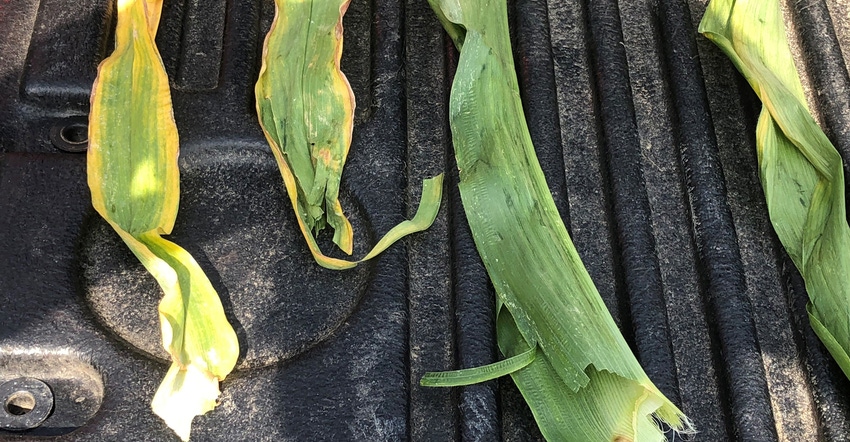
The Corn Watch ’22 field was hanging tough when Dave Nanda visited in early July in the midst of a drought, especially on soils with higher organic matter. But corn plants were already showing signs of nutrient deficiencies, mostly on the oldest, lowest leaves.
“We wouldn’t expect to see nutrient deficiencies even on those leaves if there was adequate moisture and roots were taking up nutrients properly,” says Nanda, director of genetics for Seed Genetics Direct, sponsor of Corn Watch ’22.
Related: Unlock secrets to growing more corn
That should be especially true in this field. The grower reports that over 200 pounds per acre of actual nitrogen was applied between a preplant application and starter fertilizer at planting.
Still, Nanda found leaves showing the classic signs of nitrogen deficiency, with yellow starting at the tip of the leaf and forming an inverted V as yellowing moved up the leaf. He also saw yellowing and browning along the edges of leaves, typical of potassium deficiency.
“They were signs that even though there may have been adequate nutrients in the soil, roots weren’t finding them in solution and moving them into plants,” Nanda says.
What tissue tests say
Nanda took tissue samples during this visit at the same two general locations where tissue samples were pulled at the V5 stage. He collected 25 leaves in each location, and the two samples were mailed to SureTech Labs in Indianapolis for analysis. Ceres Solutions covered the cost of shipping and processing samples. Betsy Bower, an agronomist with Ceres Solutions in west-central Indiana, interpreted the tissue test results.
“Both nitrogen and potassium were fairly low within the plants in both locations within the field,” Bower says. “They were definitely lower than when tissue tests were conducted earlier in the season.
“Important ratios were still within limits and several other nutrients were adequate, but these two key nutrients were definitely lower than we would expect.
“However, it’s not surprising considering how little rain this field received to this point. Once it rains a reasonable amount again, it will be interesting to pull tissue samples again a few days later, retest, and see if nutrient levels rebound. Experience indicates that plants should take up more nitrogen and potassium again if soil moisture conditions are corrected.”
Meanwhile, corn isn’t the only crop suffering from drought conditions. Both gardeners and commercial vegetable growers report that fresh-market tomatoes ripening in mid-July were hit with a high percentage of dry rot, causing most tomatoes to be discarded. Even tomatoes that were sprayed with fungicides during flowering were afflicted with dry rot.
Experts say that’s because the problem is insufficient uptake of calcium by the roots, caused by dry and irregular moisture due to weather patterns, not disease. Time will tell whether a return to more moisture reduces the problem later in the season.
About the Author(s)
You May Also Like




